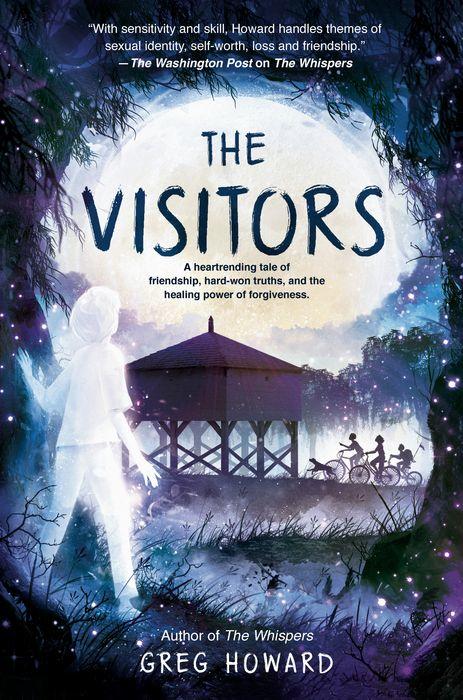Why I Wrote About Slavery in my New Middle Grade Novel, a guest post by Greg Howard

When I was young, we lived not a mile down the road from a deserted rice plantation in the Lowcountry of South Carolina. This was the early 1970s in an area of the country ripe with racial tension. The stain of slavery festered under a veneer of barely concealed animosity and sometimes open hostility against Black people. Segregation lingered there long after the rest of the country had taken its first tentative steps toward racial equality enacted by the Civil Rights Act of 1964.
My brother, our two neighbors, and I would sometimes ride our bikes down to that plantation, looking to explore the property and fill our electronic device-free lives with a bit of home-grown adventure. The plantation had a reputation of being haunted and we had our share of scares there—some likely self-manufactured and others I’m not so sure about.
ADVERTISEMENT
ADVERTISEMENT
I made that plantation the setting of my middle-grade novel, THE VISITORS, renaming it “Hollow Pines.” The name was inspired by the overabundance of Pine trees in the area and the emptiness the property so completely embodied. It was very much as Hollow Pines is described in THE VISITORS replete with sprawling Live Oaks draped with Spanish moss, a run-down manor house dotting the end of a long sandy drive, a crumbling kitchen house, and even a handful of surviving cabins in what was known as the “slave village,” their roofs sagging with the weight of time, the elements, and perhaps their own desperate memories.
I remember thinking back then that the plantation, even in its desolation and ruin, was somehow beautiful—peaceful even. Had I truly understood or been taught about the atrocities that had occurred there, I know would have viewed it differently. In fact, when I toured the property a few years ago, matured with a truer understanding of history, the plantation did not seem beautiful or peaceful at all. An overwhelming sense of sadness and anguish permeated every inch of the place—every strand of Spanish moss, every blade of grass, every grain of sand. I moved among the ruins at a snail’s pace, with a reverence I had not anticipated but which felt appropriate and essential. Gone was the bravado with which I consumed the place as a kid, gone was my inherent sense of ownership and entitlement. I owned nothing. I was entitled to nothing.
Some will likely ask why I, as a white author, chose to write about slavery at all, much less in a middle-grade novel.
First, it would have been an injustice to have the setting of a deserted rice plantation without acknowledging and paying respect to the countless Black people who would have suffered and died there. I’ve attempted to do that in THE VISITORS through the fictional enslaved characters of Cornelius, Retha Mae, Emma, and Preacher.
Second, I chose the setting out of a desire to engage young white readers with a part of our history that they simply don’t have to face if they don’t want to. Slavery in America is an ugly truth, but a truth that we need to keep telling, nonetheless. In that regard, I felt it was important not to pull any punches when it came to the subject of slavery in the book.
I recognize that as a white queer boy from a middle-income family, my challenges would have been even greater had I been a Black kid growing up in South Carolina only a decade after the Civil Rights Act was passed. My privilege also allowed me to easily swallow the white-washed history of the South with which we were constantly bombarded. In elementary and junior high school, we were required to take classes in South Carolina history. As I grew older, I would learn through books, movies, television shows, and personal relationships just how inaccurate my education had been when it came to the subject of slavery in the antebellum South.
In a conversation with a young friend who had recently graduated from high school in the South, he confirmed that his educational experience with this subject had not been all that different from the one I had decades ago. To say I was surprised and disheartened to hear this is an understatement.
But this is not solely a Southern problem.
In fact, as of this writing, more than a dozen states have recently proposed legislation limiting school instruction of how slavery, segregationist laws, and racial inequity have shaped the United States. Five states have passed such legislation.
I’ve been doing my own antiracism work over the last few years—a journey I am still on—and the amount of unlearning I had to do was not insignificant. Purging oneself of harmful practices rooted in decades of systemic racism, especially as a “son of the South,” cannot be accomplished in a couple of years by reading a dozen or so books. But understanding the human cost of slavery and recognizing how it was and still is woven into the fabric of our society, was a necessary step I had to take to reconcile the Southern culture in which I was bred with reality.
ADVERTISEMENT
ADVERTISEMENT
Overall, it’s still easy for white kids to turn a blind eye to the real and ugly truths of slavery and issues of race. My hope is that THE VISITORS will play some small part in changing that by sparking independent, critical thinking and encouraging meaningful conversations on the subject.
I believe exposing young readers to characters such as these and sharing their heartrending stories is not only appropriate but necessary to effect positive change in our society.
One thing I’ve learned is that kids can handle hard truths when given the chance. Shielding them from our history—warts and all—only temporarily delays their awareness anyway. And if there’s one thing I am absolutely amazed by, it’s this younger generation’s ability to sniff out injustice when presented with the facts.
My hope for the future lies with them.
Meet the author

Originally from the South Carolina Lowcountry, Greg Howard lives in Nashville, Tennessee, where he writes the kind of middle-grade books he wishes he’d had access to when he was young, focusing on LGBTQ+ characters and stories. Greg’s newest book, The Visitors, will be published by G.P. Putnam’s Sons/Penguin on February 1, 2022.
Connect with Greg Howard on Twitter, Instagram, and Facebook at @greghowardbooks or visit www.greghowardauthor.com
About The Visitors
From the author of The Whispers comes a heartrending tale of friendship, hard-won truths, and the healing power of forgiveness.
A lonely twelve-year-old boy spends his days “stuck” at the deserted Hollow Pines Plantation in Georgetown, South Carolina with no recollection of his name, how long he’s been there, and no idea how to leave. Things never change much for the lost souls at Hollow Pines and time is strange when you’re dead. But when visitors from the living world arrive for the first time in a long while, the boy feels a spark of hope. These visitors are around his age, and they seem to understand more than others that the plantation is not just spooky or eerie, it’s a sad place where the unspeakable happened again and again. And if these kids could understand the truth about Hollow Pines, maybe they could help him uncover the dark secrets of his past and help him find a way to finally move on. But Hollow Pines doesn’t like visitors. And with a malevolent spirit lurking in the shadows and painful memories buried deep, and for good reason, the boy wonders if he’ll ever find his way home or be stuck at Hollow Pines forever.
ISBN-13: 9780593111888
Publisher: Penguin Young Readers Group
Publication date: 02/01/2022
Age Range: 10 – 12 Years
Filed under: Uncategorized
About Amanda MacGregor
Amanda MacGregor works in an elementary library, loves dogs, and can be found on Twitter @CiteSomething.
ADVERTISEMENT
ADVERTISEMENT
SLJ Blog Network
Name That LEGO Book Cover! (#53)
Cover Reveal and Q&A: The One and Only Googoosh with Azadeh Westergaard
K is in Trouble | Review
Fighting Public School Book Bans with the Civil Rights Act
ADVERTISEMENT







